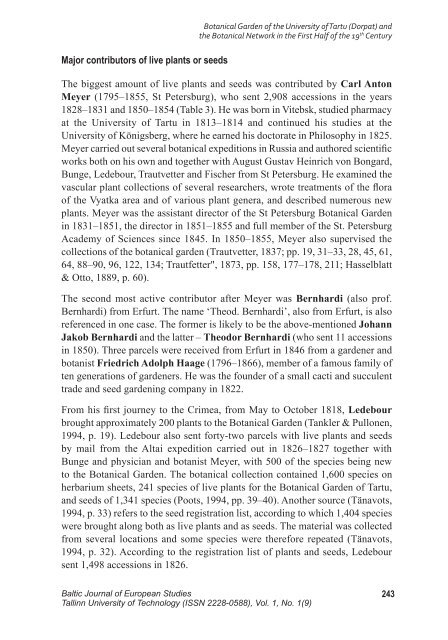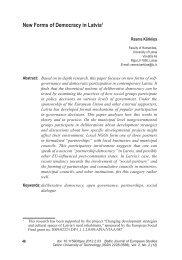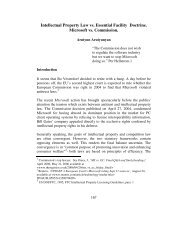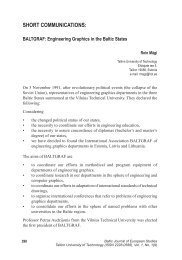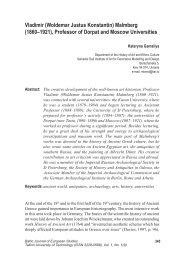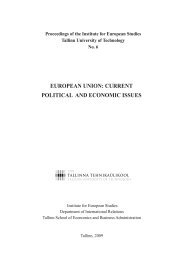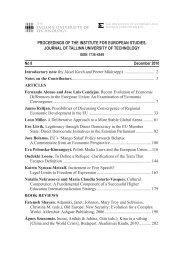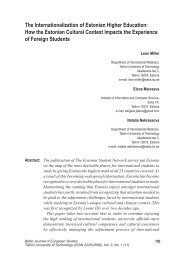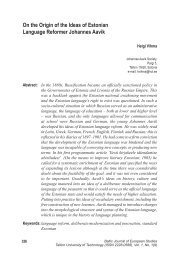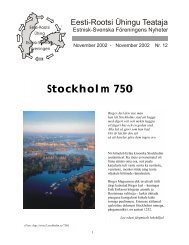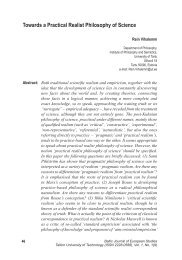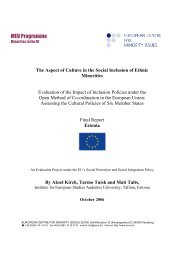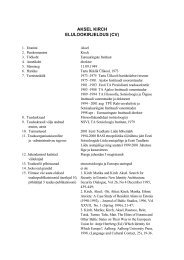Botanical Garden of the university of tartu (dorpat) - The Institute for ...
Botanical Garden of the university of tartu (dorpat) - The Institute for ...
Botanical Garden of the university of tartu (dorpat) - The Institute for ...
You also want an ePaper? Increase the reach of your titles
YUMPU automatically turns print PDFs into web optimized ePapers that Google loves.
Major contributors <strong>of</strong> live plants or seeds<br />
<strong>Botanical</strong> <strong>Garden</strong> <strong>of</strong> <strong>the</strong> University <strong>of</strong> Tartu (Dorpat) and<br />
<strong>the</strong> <strong>Botanical</strong> Network in <strong>the</strong> First Half <strong>of</strong> <strong>the</strong> 19 th Century<br />
<strong>The</strong> biggest amount <strong>of</strong> live plants and seeds was contributed by Carl Anton<br />
Meyer (1795–1855, St Petersburg), who sent 2,908 accessions in <strong>the</strong> years<br />
1828–1831 and 1850–1854 (Table 3). He was born in Vitebsk, studied pharmacy<br />
at <strong>the</strong> University <strong>of</strong> Tartu in 1813–1814 and continued his studies at <strong>the</strong><br />
University <strong>of</strong> Königsberg, where he earned his doctorate in Philosophy in 1825.<br />
Meyer carried out several botanical expeditions in Russia and authored scientific<br />
works both on his own and toge<strong>the</strong>r with August Gustav Heinrich von Bongard,<br />
Bunge, Ledebour, Trautvetter and Fischer from St Petersburg. He examined <strong>the</strong><br />
vascular plant collections <strong>of</strong> several researchers, wrote treatments <strong>of</strong> <strong>the</strong> flora<br />
<strong>of</strong> <strong>the</strong> Vyatka area and <strong>of</strong> various plant genera, and described numerous new<br />
plants. Meyer was <strong>the</strong> assistant director <strong>of</strong> <strong>the</strong> St Petersburg <strong>Botanical</strong> <strong>Garden</strong><br />
in 1831–1851, <strong>the</strong> director in 1851–1855 and full member <strong>of</strong> <strong>the</strong> St. Petersburg<br />
Academy <strong>of</strong> Sciences since 1845. In 1850–1855, Meyer also supervised <strong>the</strong><br />
collections <strong>of</strong> <strong>the</strong> botanical garden (Trautvetter, 1837; pp. 19, 31–33, 28, 45, 61,<br />
64, 88–90, 96, 122, 134; Trautfetter", 1873, pp. 158, 177–178, 211; Hasselblatt<br />
& Otto, 1889, p. 60).<br />
<strong>The</strong> second most active contributor after Meyer was Bernhardi (also pr<strong>of</strong>.<br />
Bernhardi) from Erfurt. <strong>The</strong> name ‘<strong>The</strong>od. Bernhardi’, also from Erfurt, is also<br />
referenced in one case. <strong>The</strong> <strong>for</strong>mer is likely to be <strong>the</strong> above-mentioned Johann<br />
Jakob Bernhardi and <strong>the</strong> latter – <strong>The</strong>odor Bernhardi (who sent 11 accessions<br />
in 1850). Three parcels were received from Erfurt in 1846 from a gardener and<br />
botanist Friedrich Adolph Haage (1796–1866), member <strong>of</strong> a famous family <strong>of</strong><br />
ten generations <strong>of</strong> gardeners. He was <strong>the</strong> founder <strong>of</strong> a small cacti and succulent<br />
trade and seed gardening company in 1822.<br />
From his first journey to <strong>the</strong> Crimea, from May to October 1818, Ledebour<br />
brought approximately 200 plants to <strong>the</strong> <strong>Botanical</strong> <strong>Garden</strong> (Tankler & Pullonen,<br />
1994, p. 19). Ledebour also sent <strong>for</strong>ty-two parcels with live plants and seeds<br />
by mail from <strong>the</strong> Altai expedition carried out in 1826–1827 toge<strong>the</strong>r with<br />
Bunge and physician and botanist Meyer, with 500 <strong>of</strong> <strong>the</strong> species being new<br />
to <strong>the</strong> <strong>Botanical</strong> <strong>Garden</strong>. <strong>The</strong> botanical collection contained 1,600 species on<br />
herbarium sheets, 241 species <strong>of</strong> live plants <strong>for</strong> <strong>the</strong> <strong>Botanical</strong> <strong>Garden</strong> <strong>of</strong> Tartu,<br />
and seeds <strong>of</strong> 1,341 species (Poots, 1994, pp. 39–40). Ano<strong>the</strong>r source (Tänavots,<br />
1994, p. 33) refers to <strong>the</strong> seed registration list, according to which 1,404 species<br />
were brought along both as live plants and as seeds. <strong>The</strong> material was collected<br />
from several locations and some species were <strong>the</strong>re<strong>for</strong>e repeated (Tänavots,<br />
1994, p. 32). According to <strong>the</strong> registration list <strong>of</strong> plants and seeds, Ledebour<br />
sent 1,498 accessions in 1826.<br />
Baltic Journal <strong>of</strong> European Studies<br />
Tallinn University <strong>of</strong> Technology (ISSN 2228-0588), Vol. 1, No. 1(9)<br />
243


